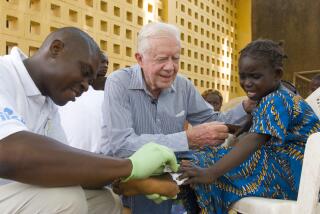Targeting the Heart of Darkness
- Share via
The vision of a young child leading a sightless parent or grandparent is common throughout Africa, where blindness is endemic. American companies and the World Health Organization hope to make that scene a thing of the past, however.
Public health authorities are already making a major dent in the spread of river blindness, or onchocerciasis, which has blinded 340,000 Africans. The disease is caused by a parasitic worm carried from person to person by the black fly, which breeds in fast-flowing rivers.
One tablet per year of the drug ivermectin is sufficient to kill the worms, and Merck & Co. has been donating the drug to WHO since 1988. Health officials hope to have river blindness eradicated in Africa shortly after the turn of the century.
Now another drug company is teaming up with WHO and a private foundation in a $66-million program to attack a much more common cause of blindness, a bacterial infection known as trachoma. Pfizer Inc. will donate nearly $60 million worth of one of its leading antibiotics--enough to treat 3 million people--to begin a program in five Asian and African countries severely affected by the disease.
Pfizer and the Edna McConnell Clark Foundation will also donate $7 million in cash to support drug distribution and public health programs to slow the spread of the disease.
Trachoma is caused by Chlamydia trachomatis, a close relative of the bacteria that cause genital chlamydial infections in the United States. No one knows why C. trachomatis infects the eyes rather than the genitalia, but its effects can be devastating over long periods.
Stringent Measures
Trachoma was common in the United States and Europe at the beginning of this century, but sanitary measures largely wiped it out and stringent efforts were carried out to prevent its return. Inspectors at Ellis Island would lift the eyelids of immigrants, for example, checking for evidence of infection. Those who were infected were turned back immediately. Sporadic cases do occur, often on Indian reservations.
In the rest of the world, 540 million people live in areas where the disease is endemic and 150 million have active infections. Six million of those have been blinded, making trachoma the second leading cause of blindness worldwide, trailing only glaucoma.
When people get trachoma, they do not go blind immediately. They develop a sticky discharge from the eyes and nose. Fresh water to wash away the discharge is often not available, and bacteria in the discharge are readily passed from one person to another, particularly from children to other children or to their mothers. Two-thirds to three-quarters of the blind are women, most of whom have been infected by their children, and three-quarters of the active infections are among children.
Flies also are attracted to the discharge and may pass the bacteria from person to person.
Untreated, the repetitive infections scar the inner eyelid. Excessive scarring forces the eyelid to turn inward, causing the eyelashes to damage the cornea by rubbing against it, which leads to blindness. Most victims develop blindness in their 30s and 40s--a period that otherwise would represent the most productive years of their lives.
The standard treatment is a tetracycline ointment that is rubbed on the eyes twice a day for six weeks. But the ointment stings and many victims, especially children, don’t finish the regimen.
Public health officials knew that improved sanitation was a major element in fighting trachoma, but they also needed a more effective treatment. “The missing piece of the puzzle was a long-acting antibiotic,” said Michael Bailin, president of the Clark Foundation.
Enter azithromycin, developed by Pfizer to treat genital chlamydial infections. The drug is very effective at curing such infections with only one dose, and the company has worldwide sales of the drug, trade-named Zithromax, of about $1 billion per year.
Successful Approach
A pilot program in two remote areas of southern Morocco demonstrated that a single injection of the antibiotic could protect people from trachoma for a year. The program reduced trachoma prevalence by about 40% in the regions, according to Moroccan health authorities.
That program used an approach that will be adopted in the forthcoming International Trachoma Initiative. In villages where more than 20% of residents are infected, all women and children are treated. If the incidence is less than 20%, then the team is more selective, giving the drug to infected people and their close contacts. The goal in both cases is to interrupt transmission by curing everyone who is or might be infected.
Antibiotics alone are not enough to eradicate the disease. The new initiative is thus based on a four-part protocol called SAFE, for Surgery, Antibiotics, Face Washing and Environmental changes.
Field personnel are being taught a 15-minute surgical procedure that restores the eyelid to its normal shape for those with a severe form of the disease. Villagers also are being taught to wash their faces regularly. Three handfuls of water per person per day can drastically reduce transmission of the bacteria. Environmental changes include better access to clean water, sanitation and health education.
Such changes will require a substantial effort by the host country, so the initiative is focusing its initial efforts on five countries that have committed to such a program: Morocco, Ghana, Mali, Tanzania and Vietnam.
The team hopes to begin administering the drugs by the fall of 1999, said Dr. Joseph Cook of the Clark Foundation. The program eventually will be expanded to 12 more countries.
More to Read
Sign up for Essential California
The most important California stories and recommendations in your inbox every morning.
You may occasionally receive promotional content from the Los Angeles Times.










